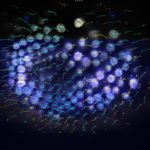Link to Pubmed [PMID] – 32081880
Link to DOI – 10.1038/s41598-020-57808-y
Sci Rep 2020 02; 10(1): 3131
The success of filamentous fungi in colonizing most natural environments can be largely attributed to their ability to form an expanding interconnected network, the mycelium, or thallus, constituted by a collection of hyphal apexes in motion producing hyphae and subject to branching and fusion. In this work, we characterize the hyphal network expansion and the structure of the fungus Podospora anserina under controlled culture conditions. To this end, temporal series of pictures of the network dynamics are produced, starting from germinating ascospores and ending when the network reaches a few centimeters width, with a typical image resolution of several micrometers. The completely automated image reconstruction steps allow an easy post-processing and a quantitative analysis of the dynamics. The main features of the evolution of the hyphal network, such as the total length L of the mycelium, the number of “nodes” (or crossing points) N and the number of apexes A, can then be precisely quantified. Beyond these main features, the determination of the distribution of the intra-thallus surfaces (Si) and the statistical analysis of some local measures of N, A and L give new insights on the dynamics of expanding fungal networks. Based on these results, we now aim at developing robust and versatile discrete/continuous mathematical models to further understand the key mechanisms driving the development of the fungus thallus.

